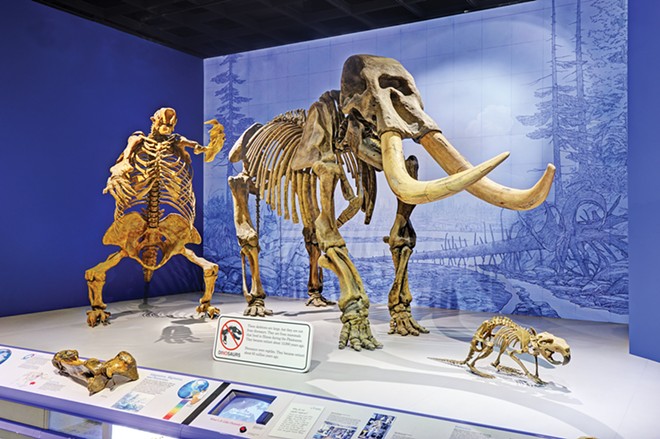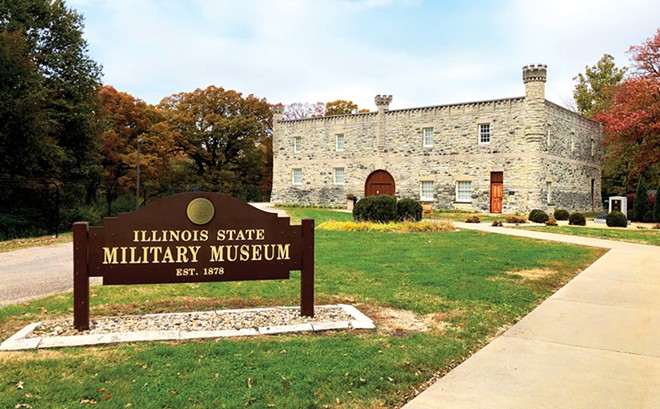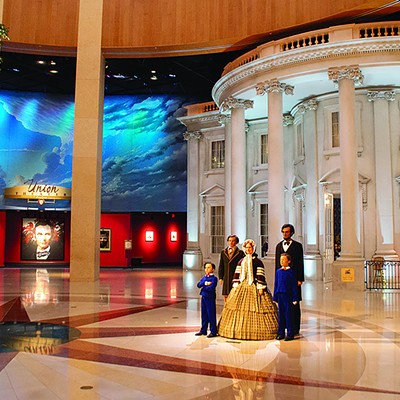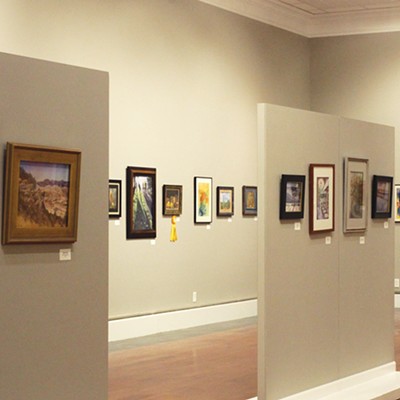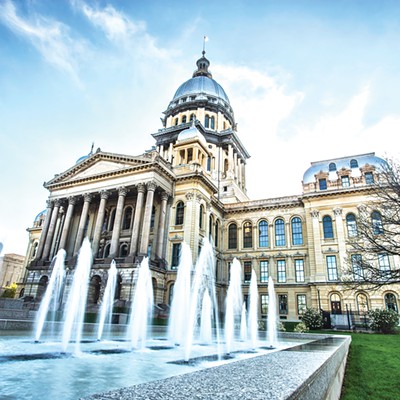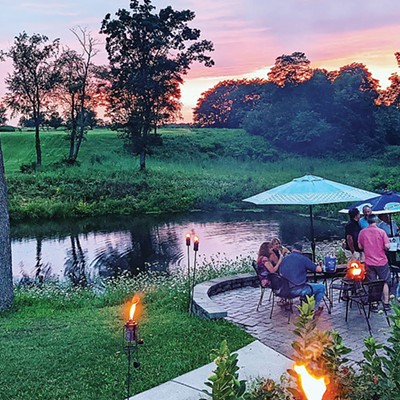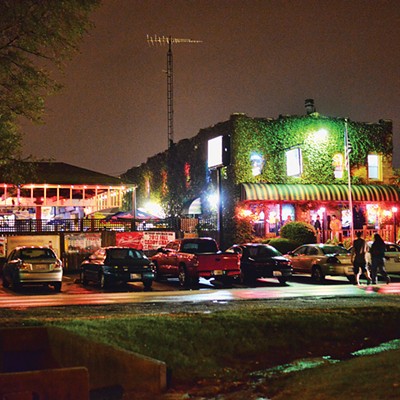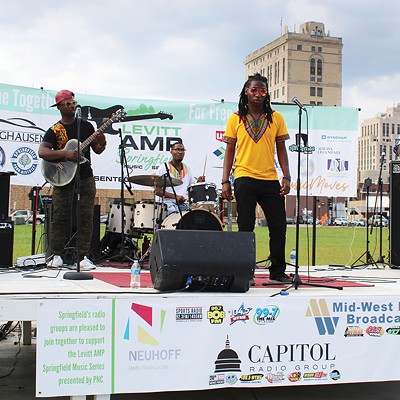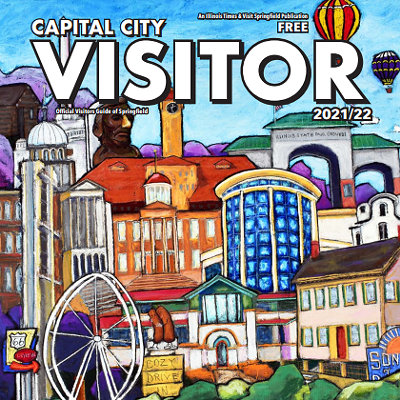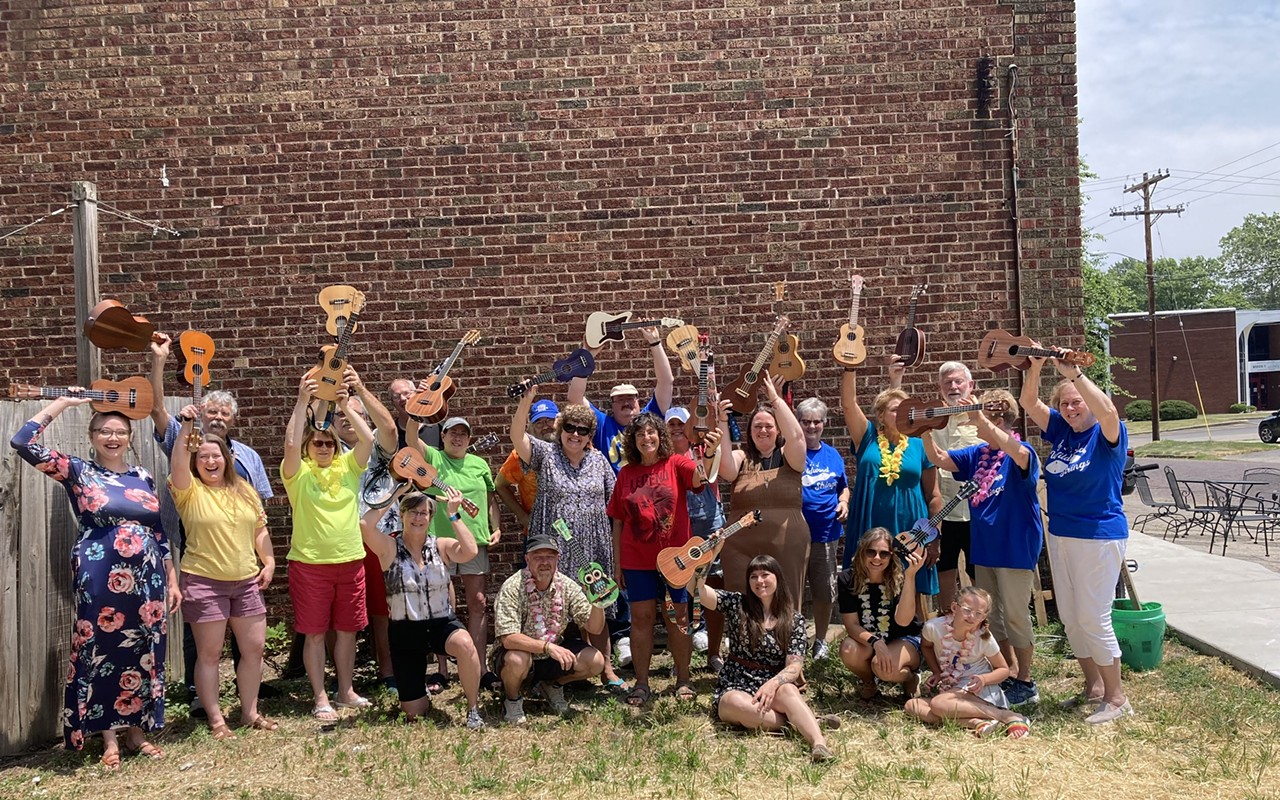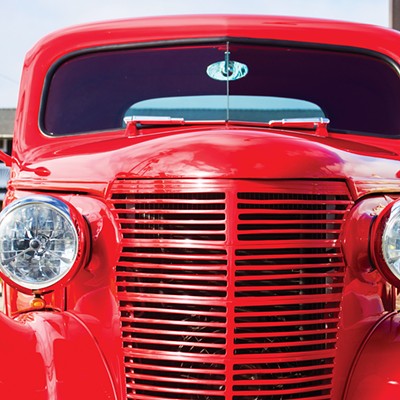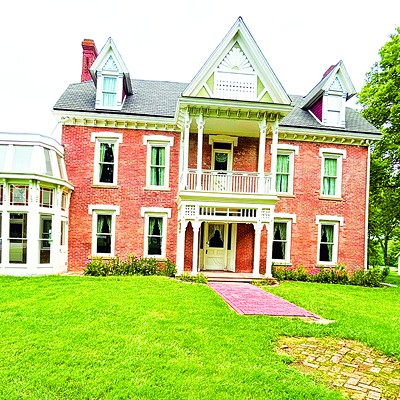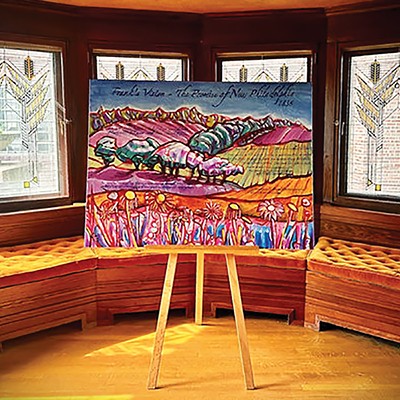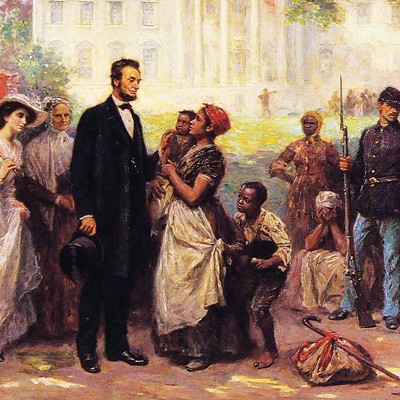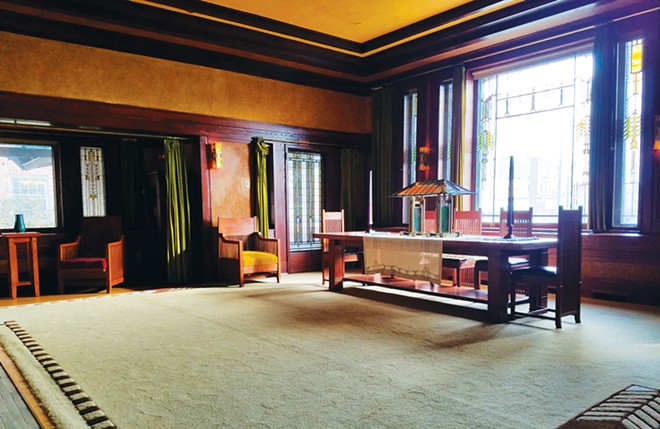
Due to COVID-19 restrictions, it is advised to check individual websites for up-to-date information and offerings
DOWNTOWN AREA
Dana-Thomas House - A Frank Lloyd Wright design
301 E. Lawrence Ave.
217-782-6776
http://historicspringfield.dnr.illinois.gov/
Facebook.com/StateHistoricSitesOfSpringfieldIL
Donations accepted
A visit to Springfield is not complete without touring the magnificent Frank Lloyd Wright-designed Dana-Thomas House. The home contains the largest collection of site-specific, original Wright art glass and furniture and was Wright's first "blank check" commission.
In 1902, Susan Lawrence Dana commissioned architect Frank Lloyd Wright to design a new residence around the existing family home. Dana spared no expense, and Wright went all-out in what's considered one of his first full expressions of the Prairie Style. When it was finished in 1904, the $60,000 project was the largest residence Wright had built – 35 rooms on three levels, encompassing 12,000 square feet of living space. Dana loved to entertain, and her house was designed with that purpose in mind. The grand entrance is theatrical; one enters the house as though walking onto a stage. The three floors contain 16 varying levels.
In the early 1980s, to preserve this architectural gem, the state of Illinois acquired the residence from then-owner Thomas Publishing.
The house contains the largest collection of Wright furniture and art-glass windows in the world. The house also features a panoramic mural, created by internationally renowned artist George Niedecken, who painted many murals for Wright. Susan Lawrence Dana was a Springfield-area leader of the suffrage movement and advocated for an equal rights amendment during the 1920s.
Events at the Dana-Thomas House include concerts, tours, and floral designs during the holidays. The State Historic Sites at Springfield are managed by the Illinois Department of Natural Resources, Office of Land Management.
Elijah Iles House
628 S. Seventh St.
Open Sat. 12-4 p.m., or call
217-679-0797
ileshouse.org
Donations accepted
The Elijah Iles House is thought to date from 1837. Elijah Iles, a founder of Springfield, and wife Malinda lived here; it is the city's oldest home still in original design. There is evidence that the same architect who designed the Old State Capitol built it. It is one of the state's earliest residences in the Greek Revival style. Two of Springfield's most famous citizens, Abraham Lincoln and poet Vachel Lindsay, are known to have visited the house later. Lincoln was a guest of Robert Irwin, and they enjoyed many a card game in the parlor. Because of the house's impressive architecture and rich history, it was placed on the National Register of Historic Places in 1978. It had to be moved from two earlier locations, finding its current home at the corner of Seventh and Cook streets in 1998. An elevator, accessible from special parking behind the house, provides access to visitors with limited mobility. The Farrell and Ann Gay Museum of Springfield History is in the lower level. Upstairs is an all-new exhibit: art and furnishings from the home of Phyllis Herndon Brissenden (d. 2019).
Illinois State Museum
502 S. Spring St.
217-782-7386
illinoisstatemuseum.org
Admission
Visitors to the Illinois State Museum are treated to world-renowned exhibits and engaging educational programs. The Museum tells the rich story of Illinois' land, life, people and art. Three floors of permanent and changing exhibits display a vast array of items drawn from the Museum's collection of over 13.5 million objects. Adults and children alike will enjoy traveling back in time to the days when a shallow, tropical sea-covered Illinois or Ice Age behemoths roamed the glacial expenses, as well as learning about 12,000 years of Illinois' human history. Rotating art exhibitions demonstrate the rich tradition of both decorative and fine art within Illinois. This museum truly is a Springfield gem.
Route History, Inc.
Facebook.com/VisitRouteHistory
www.routehistory.net
Admission
A museum and souvenir shop where visitors can experience and learn about the tragedy, resilience and excellence of Black people, Black-owned businesses and related events and places located along historic Route 66. Learn about pioneers that made significant contributions to Illinois, the city of Springfield and the greater society. Of note are Springfield's roles as a haven along the Underground Railroad, the Race Riot of 1908 which led to the formation of the NAACP and the lifesaving commodities and guidance provided by Black-owned businesses during the Jim Crow era.
Vachel Lindsay Home State Historic Site
603 S. Fifth St.
217-524-0901
http://historicspringfield.dnr.illinois.gov/
Facebook.com/StateHistoricSitesOfSpringfieldIL
Donations accepted
"Prairie troubadour" Vachel Lindsay captured the attention of audiences around the world during the early 1900s. He was born on Nov. 10, 1879, and died on Dec. 5, 1931. Both events took place in the Lindsay family home across the street from the Illinois Governor's Mansion. Lindsay's father, Thomas, was a physician; his mother, Catherine, was an artist and social reformer. Lindsay was supposed to follow in his father's footsteps, and after high school he attended Hiram College in Ohio to study medicine, but he eventually dropped out to attend art schools in Chicago and New York.
In the early 20th century, Lindsay set out on a series of tramps across America. At the conclusion of one of these trips, his poem "General William Booth Enters into Heaven," a eulogy to the founder of the Salvation Army, was published in Chicago's Poetry magazine. The poem brought him national attention, and subsequent works garnered international acclaim. Some of his best-known poems include "The Congo" and "Abraham Lincoln Walks at Midnight."
Lindsay's family home, now a state historic site, has been restored to depict life in 1917, when Lindsay's parents still played an active role in community life. Examples of Lindsay's poetry and art, not a part of the house at that time, have been added to showcase the poet. Events include poetry readings and writing workshops. The State Historic Sites at Springfield are managed by the Illinois Department of Natural Resources, Office of Land Management.
Grand Army of the Republic Memorial Museum
629 S. Seventh St.
217-522-4373
womansreliefcorp.org
Donations accepted
As the soldiers who fought in the bloody Civil War returned to civilian life, many retained the bonds of brotherhood forged in battle. Several fraternal organizations of Civil War veterans sprang up, and the Grand Army of the Republic, established in Decatur in 1866, became a leader among them, with more than 409,000 members who previously served in the Union forces. The Grand Army of the Republic Memorial Museum in Springfield memorializes those veterans and sits within walking distance of the Lincoln Home and across the street from the Elijah Iles House.
The collection includes tintype photos by Mathew Brady, rare drawings of the infamous Andersonville and Libby prison camps, and a complete list of Union soldiers held there during the war. Owned by the National Woman's Relief Corps, an auxiliary to the Grand Army of the Republic, the museum also maintains many volumes of Civil War history that may be examined on-site.
NORTH OF DOWNTOWN SPRINGFIELD
Springfield and Central Illinois African American History Museum
1440 Monument Ave.
217-391-6323
spiaahm.org
tions accepted
The Museum opened in 2012, and is located at the main entrance to Oak Ridge Cemetery, within walking distance of Lincoln's Tomb. Exhibits tell authentic stories about African American life in central Illinois, past and present. Some of the exhibits featured include: The Middle Passage, documenting the slave trade; "Something So Horrible, The Springfield Race Riot of 1908," which led to the formation of the NAACP; Oldest Springfield African American Churches dating back to 1838 and Central Illinois Pioneer Families from the 1800s to the present. These extensively researched exhibits are interactive and have audio visual components.
Illinois War Memorials
1441 Monument Ave.
217-782-2717
http://historicspringfield.dnr.illinois.gov/
Facebook.com/StateHistoricSitesOfSpringfieldIL
World War II Illinois Veterans Memorial in Oak Ridge Cemetery was constructed to honor the 987,000 men and women from Illinois who served our country during World War II, when 22,000 Illinois citizens gave their lives in pursuit of liberty. The memorial design centerpiece is a globe 12 feet in diameter, which represents the world in conflict during World War II. It is surrounded by a granite wall engraved with the names and dates of major battles of the Pacific and European theaters of war. A central plaza of personalized engraved bricks completes the design.
The Illinois Korean War Memorial, dedicated on June 16, 1996, is also located in Oak Ridge Cemetery. The monument's centerpiece is a 12-foot bronze bell surrounded by four larger-than-life warriors representing the five branches of the armed forces – Army, Navy, Coast Guard, Air Force and Marines. The names of over 1,700 Illinoisans killed in Korea are inscribed along eight walls of the memorial's granite base.
The Illinois Vietnam Veterans Memorial was dedicated in May 1988. The memorial incorporates five black granite walls upon which are inscribed the 2,970 names of Illinoisans who died or are still missing. The five black granite walls form interior courtyards, one for each of the five branches of service. Each branch of service is designated by its insignia, which is etched on inner 15-foot-high gray granite walls. Also inscribed on the gray granite walls are the names of those listed as missing in action or as prisoners of war, as well as the names of the highest decorated veterans in each branch of service. An eternal flame burns atop the memorial where the gray granite walls converge.
Dedicated in 2016, The Illinois Purple Heart Memorial honors recipients of the Purple Heart killed or wounded from all wars the United States has participated in. The center of the Memorial includes an eight-foot piece of black granite with an engraving of a Purple Heart on it. The other side of the stone features a quote from William Shakespeare's Henry V: "We few, we happy few, we band of brothers; For he to-day that sheds his blood with me shall be my brother." Two smaller black granite stones to the left and right of the centerpiece of the Memorial feature the engravings of four soldiers.
The State Historic Sites at Springfield are managed by the Illinois Department of Natural Resources, Office of Land Management.
Illinois State Military Museum
Camp Lincoln
1301 N. MacArthur Blvd.
217-761-3910
facebook.com/illinois.state.military.museum
Donations accepted
Located on the grounds of Camp Lincoln, headquarters of the Illinois National Guard, the Illinois State Military Museum is dedicated to the state's military heritage and collecting, preserving, interpreting and exhibiting the military artifacts associated with the citizen-soldier of Illinois. The Citizen-Soldier exhibit features the military experiences of famous Illinois soldiers such as Carl Sandburg, Robert McCormick, John A. Logan and Abraham Lincoln.
While you're there, take a close look at the target board used by Abraham Lincoln in 1863 to test-fire the new Spencer rifle, or ask about the museum's collection of Civil War flags currently held in storage but viewable by the public. A realistic World War II scene depicts Illinois' 132nd Infantry in combat on Guadalcanal in 1942. Displayed outside are restored Vietnam War-era AH-1 Cobra and UH-1 "Huey" helicopters and an M60A-3 tank.
The Pearson Museum
801 N. Rutledge St.
217-545-2155
Free
Located in the Southern Illinois University School of Medicine, this teaching museum covers various aspects of healing, including pharmaceutical, surgical, dental and alternative medicine. Treatments through the centuries come to life in permanent and changing exhibits. Named for long-practicing Springfield physician Emmett Pearson, the museum features a dental exhibit, a complete homeopathic dispensary and an entire 1900 drugstore from Canton, Illinois, with its many apothecary jars and vials. School groups and practicing physicians often visit the museum to hear lectures. Open by appointment.
Air Combat Museum
Abraham Lincoln Capital Airport
835 S. Airport Rd.
217-522-2181
aircombatmuseum.org
Donations accepted
The Air Combat Museum showcases the role of military aviation and features a collection of historic aircraft and aviation memorabilia including a P-51 Mustang, a Vought F4U-5 Corsair, a P40 under restoration, a Beechcraft AT-11 used to train bombardiers in World War II, a 1931 Fleet Model 9 biplane and a Soko G-21 Galeb Yugoslavian jet, among others. A WWI-replica Sopwith Camel is being built on the premises. For individual visits, donations are suggested. Group tours are $40, by appointment only.
Daughters of Union Veterans of the Civil War Museum
503 S. Walnut St.
217-544-0616
duvcw.org
Free
The museum preserves countless artifacts of Civil War history, including rifles, medals, photographs, currency, drums, uniforms and letters from soldiers at the front. A gift shop offers a variety of books about the Civil War and other memorabilia. Located next to the Museum is an American foursquare-style house built in 1898, dedicated as the Dr. Benjamin Franklin Stephenson Library and Research Center, the founder of the Grand Army of the Republic. The library houses a complete set of "War of the Rebellion: Official Records of the Union and Confederate Armies." Numerous other volumes are also available for on-site research.
NEARBY
Camp Butler National Cemetery
5063 Camp Butler Rd.
217-492-4070
www.cem.va.gov/cems/nchp/campbutler.asp
One of 14 sites designated national cemeteries by President Abraham Lincoln, Camp Butler was also used to train Union troops and served as a prisoner-of-war camp during the Civil War. Some 800 Confederate soldiers are buried here. So, too, are 39 German and four Italian military personnel and a Korean spy who was working for Germany, interred here after unsuccessful efforts to locate their kin after World War II. The site has an outside touch-screen kiosk that permits visitors to locate the graves of soldiers buried at Camp Butler.
Clayville Historic Site
12828 State Route 125 (about a mile east of Pleasant Plains)
From Springfield, take Jefferson Street west and stay to the left on 125 where Route 97 (the road to New Salem) breaks north.
217-481-4430
clayville.org
Donations accepted
Visit the oldest brick building in Sangamon County and second-oldest in the state of Illinois. Built in 1824 by the Broadwell family, it was the stagecoach stop, inn and tavern on the old post road to Beardstown. The 14-acre pioneer site includes two log cabins, both moved to the site in the early 1960s. The Batterton cabin was constructed in 1817 and represents early pioneer life, perhaps similar to the cabin John Broadwell would have constructed when he arrived in 1819. Two large 1850s-era barns were also moved to the site and reconstructed. One barn holds the pioneer agriculture museum and the other has been updated as a venue rental space and includes an open-air pavilion with a large stone fireplace. The Rustemeyer Blacksmith Shop, the last active blacksmith shop in Springfield, has also been relocated here. Don't forget to stop by the reconstructed school house; rumor has it that a young Abraham Lincoln would stop and visit his friend Mentor Graham, who was a teacher at the school, and listen to the students read their lessons. In 1842, the first Whig Party state convention was held at Clayville, named after candidate Henry Clays. Guided tours are available by appointment, or visitors may just wander the grounds.
Abraham Lincoln Long Nine Museum
200 S. Main St., Athens (12 miles north of Springfield on Rte. 29; also take I-55, Williamsville Exit 109, then west seven miles. Athens is seven miles east of Lincoln's New Salem State Historic Site).
217-361-7857
Abrahamlincolnlongninemuseum.com
Donations accepted
Located in the original 1831-32 Col. Matthew Rogers Building. On Aug. 3, 1837, Abraham Lincoln and most of the other "Long Nine" legislators from Sangamon County were present at the Rogers Building to be honored at a banquet for helping pass the bill to move the state capital to Springfield. Exhibits include recreated banquet area, audio-narrated dioramas showing Lincoln's activities in the Athens area while he was living in nearby New Salem, a biography room, history room and remnants of the "Lincoln Stairs" – used by Lincoln and the others to reach the second-floor banquet area. Tours are self-guided. Open Tuesday-Sunday, 1-5 p.m., from June 1 through Aug. 29.

